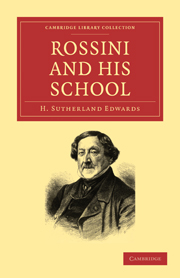Book contents
- Frontmatter
- Contents
- CHAP. I ROSSINI'S CHILDHOOD AND YOUTH
- CHAP. II LA PIETEA DEL PARAGONE
- CHAP. III ITALIAN OPERA UNTIL THE TIME OF ROSSINI
- CHAP. IV TANCREDI
- CHAP. V OPERATIC CUSTOMS IN ROSSINI'S TIME
- CHAP. VI ROSSINI AT NAPLES
- CHAP. VII PREPARATIONS FOR THE BARBER
- CHAP. VIII IL BARBIERE
- CHAP. IX ROSSINI AND THE COMIC IN MUSIC
- CHAP. X FROM OTELLO TO SEMIKAMIDE
- CHAP. XI ROSSINI ON HIS TRAVELS
- CHAP. XII DONIZETTI
- CHAP. XIII VERDI
- LIST OF ROSSINI'S PUBLISHED WORKS
CHAP. XII - DONIZETTI
Published online by Cambridge University Press: 29 August 2010
- Frontmatter
- Contents
- CHAP. I ROSSINI'S CHILDHOOD AND YOUTH
- CHAP. II LA PIETEA DEL PARAGONE
- CHAP. III ITALIAN OPERA UNTIL THE TIME OF ROSSINI
- CHAP. IV TANCREDI
- CHAP. V OPERATIC CUSTOMS IN ROSSINI'S TIME
- CHAP. VI ROSSINI AT NAPLES
- CHAP. VII PREPARATIONS FOR THE BARBER
- CHAP. VIII IL BARBIERE
- CHAP. IX ROSSINI AND THE COMIC IN MUSIC
- CHAP. X FROM OTELLO TO SEMIKAMIDE
- CHAP. XI ROSSINI ON HIS TRAVELS
- CHAP. XII DONIZETTI
- CHAP. XIII VERDI
- LIST OF ROSSINI'S PUBLISHED WORKS
Summary
Donizetti, Rossini's immediate successor but not supplanter, composed from sixty to seventy operas (“c'est beaucoup” dirait Candide) of which to this day three at least (“c'est beaucoup” dirait Martin), are still played regularly every season in London: Lucia, Lucrezia, and La Favorita. Of his two charming works in the light style—comic operas in which the composer never approaches the farcical, never once ceases to be graceful—neither L'Elisir nor Don Pasquale can be compared to the much more vigorous Barber. Nor has Donizetti produced any work so full of melody as Semiramide, or so dramatic as William Tell. But he rises to unwonted heights in the last act of La Favorite; which, composed for the French Académie, became naturalised in due time on the Italian operatic stage under the title of La Favorita.
Although the career of Donizetti was very much longer than that of Bellini, whom he preceded and whom he survived, he produced in proportion to the number of his works fewer by a great deal which have kept the stage.
Donizetti brought out his first opera Enrico di Borgogna at Venice in 1818, when he was twenty years of age, and Catarina Cornaro, his sixty-third (not to count two or three that were never produced) at Naples, in 1844, when he was forty-six.
- Type
- Chapter
- Information
- Rossini and his School , pp. 89 - 105Publisher: Cambridge University PressPrint publication year: 2009First published in: 1881



